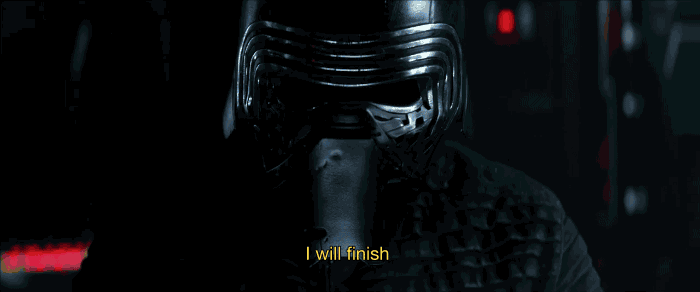Star Wars: The Force Awakens’ Kylo Ren is the perfect villainous heir to Anakin Skywalker: He is as emotionally volatile and unpredictable in his struggle between the Dark Side and the Light, and as compelling as Anakin should have been in the prequels.
And yet, Leia Organa and Han Solo’s son has proven divisive among some moviegoers, who find the notion of a raven-haired Girls bro (Adam Driver) as this generation’s Darth Vader laughable.
Some, like Han, see “too much Vader” in Kylo—meaning too much of prequel-Anakin’s tedious tantrums and moodiness. (His angst has even inspired a brilliant parody Twitter account, “Emo Kylo Ren.”)
Others take issue with Ren’s decision to unmask himself midway through the film, well before his climactic confrontation with Han on Starkiller Base.
Then there are those who agree with the Vatican’s anonymous film critic, who derides Ren as a pale imitation of Vader in L’Osservatore Romano and writes that he “fails most spectacularly” as a “representation of evil.”
But is Ren meant to be a “representation of evil?” (No, of course he’s not.) And why is this Star Wars villain more polarizing than any other, including those he shares DNA with? The answers, it seems, are all in his face.
Kylo Ren spends most of The Force Awakens as a robotic-voiced, masked harbinger of death. We meet him amid the destruction of a Jakku village, where we witness his formidable Force ability when he stops a blaster shot mid-air. Soon, he’s sentenced those innocent villagers to death, and personally executed Lor San Tekka, an elderly figure from Ren’s past.
The more we learn about Ren, the more frightening he becomes: we learn that he betrayed Luke Skywalker and massacred his school of padawans. We discover his devotion to Vader’s hate-filled legacy as he channels his inner Hamlet, delivering a moody monologue to Darth’s mangled helmet, and witness his destructive outbursts of anger. We see that he is consumed by wild, negative emotion—the most dangerous thing a Force-wielder can be.

And we genuinely fear for Rey when Ren captures her and binds her to a torture chair. (“You know I can take whatever I want,” he soon tells her, Force-probing her memories against her will.)
Then Ren takes off his mask.
At this point, audience reactions go scattering faster than the pulverized remnants of Alderaan. Some people laugh—and who could blame them? Traditionally, a sight like Driver (and his shiny, shiny hair) is not what we’ve come to expect from a Star Wars villain’s mask removal.
But that face—that of a normal, vulnerable young man—is the most subversively terrifying thing about J.J. Abrams’ reimagining of A New Hope. Rather than pure evil, Ren is something far more familiar: He is human. Just like the real-life young men with minds clouded by fear, hate, and anger who commit unspeakable acts in our world every day.
It would be impossible to make that point, however, without showing the turmoil within Ren. Those tantrums, those tears, that surprisingly young, bare face—all the visual cues that leave the character open to criticisms of not being “evil” enough—are all signs of Ren’s struggle between the Dark Side and the Light. To dismiss them is to dismiss the essence of Star Wars.
When Ren lures Han Solo onto the bridge at Starkiller Base, both sides of the Force are still warring across his face. As the Death Star 3.0 absorbs the final surges of solar power it needs to annihilate the Hosnian system and the Galactic Senate, Ren’s face is split in two—one half covered in shadows, the other bathed in light.
“I’m being torn apart,” Ren tells his father, eyes welling with tears. “I know what I have to do but I don’t know if I have the strength to do it. Will you help me?” He hands Han his lightsaber hilt, a conflicted gesture that could be construed as a silent plea for an end to his pain (death, perhaps)—or a ploy to put Han off his guard. More likely, it’s some inscrutable combination of both.
“Yes, anything,” Han replies with resolute open-heartedness—a trait Ren seemingly interprets as weakness. The sky goes dark and shadows consume the rest of Ren’s face. He makes a choice: he ignites the blade straight through his father’s heart, proving to himself (if to no one else) that he has what it takes to devote himself to the Dark Side.
When A New Hope hit theaters in 1977, no one in the audience knew that Darth Vader was Luke’s father, or that he had ever trained to become a Jedi, or that he was once the Chosen One. He was a cipher—nothing more than power, evil, and a mask.
Ren, on the other hand, is a living battleground between darkness and light, making him a far more resonant and familiar portrayal of that struggle than we’ve ever seen in Star Wars. While Vader’s fate was sealed long before A New Hope, Ren still has a choice—and a face. That, for my money, makes him a far more interesting villain.





